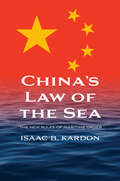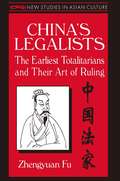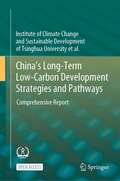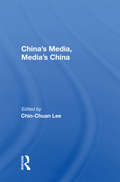- Table View
- List View
China’s Law of the Sea: The New Rules of Maritime Order
by Isaac B. KardonAn in-depth examination of the law and geopolitics of China’s maritime disputes and their implications for the rules of the international law of the sea China’s Law of the Sea is the first comprehensive study of the law and geopolitics of China’s maritime disputes. It provides a rigorous empirical account of whether and how China is changing “the rules” of international order—specifically, the international law of the sea. Conflicts over specific rules lie at the heart of the disputes, which are about much more than sovereignty over islands and rocks in the South and East China Seas. Instead, the main contests concern the strategic maritime space associated with those islands. To consolidate control over this vital maritime space, China’s leaders have begun to implement “China’s law of the sea”: building domestic legal institutions, bureaucratic organizations, and a naval and maritime law enforcement apparatus to establish China’s preferred maritime rules on the water and in the diplomatic arena. Isaac B. Kardon examines China’s laws and policies to defend, exploit, study, administer, surveil, and patrol disputed waters. He also considers other claimants’ reactions to these Chinese practices, because other states must acquiesce for China’s preferences to become international rules. China’s maritime disputes offer unique insights into the nature and scope of China’s challenge to international order.
China's Leaders: From Mao to Now
by David ShambaughSince the founding of the People’s Republic of China over 70 years ago, five paramount leaders have shaped the fates and fortunes of the nation and the ruling Chinese Communist Party: Mao Zedong, Deng Xiaoping, Jiang Zemin, Hu Jintao, and Xi Jinping. Under their leaderships, China has undergone an extraordinary transformation from an undeveloped and insular country to a comprehensive world power. In this definitive study, renowned Sinologist David Shambaugh offers a refreshing account of China’s dramatic post-revolutionary history through the prism of those who ruled it. Exploring the persona, formative socialization, psychology, and professional experiences of each leader, Shambaugh shows how their differing leadership styles and tactics of rule shaped China domestically and internationally: Mao was a populist tyrant, Deng a pragmatic Leninist, Jiang a bureaucratic politician, Hu a technocratic apparatchik, and Xi a modern emperor. Covering the full scope of these leaders’ personalities and power, this is an illuminating guide to China’s modern history and understanding how China has become the superpower of today.
China's Legalists: The Early Totalitarians
by Zhengyuan FuThis text discusses the Chinese Legalists, an ancient school of Chinese philosophy which flourished during the Period of the Hundred Contending Schools (6th-3rd century B.C.E.) The school perfected the science of government and art of statecraft to a level that would have greatly impressed Machiavelli. This period and its personalities, as well as a taste of the style and spirit of the Legalists' discourse, are made accessible to the student and general reader, placing into focus the roots of the great Chinese philosophy-as-statecraft tradition. The Legalists - most famously Li Kui, Shang Yang, Shen Buhai, Shen Dao, and Han Fei - had a great impact not only on the institutions and practices of Chinese imperial tradition but also on the Maoist totalitarianism of the People's Republic of China.
China's Legalists: The Early Totalitarians (New Studies In Asian Culture)
by Zhengyuan FuThis text discusses the Chinese Legalists, an ancient school of Chinese philosophy which flourished during the Period of the Hundred Contending Schools (6th-3rd century B.C.E.) The school perfected the science of government and art of statecraft to a level that would have greatly impressed Machiavelli. This period and its personalities, as well as a taste of the style and spirit of the Legalists' discourse, are made accessible to the student and general reader, placing into focus the roots of the great Chinese philosophy-as-statecraft tradition. The Legalists - most famously Li Kui, Shang Yang, Shen Buhai, Shen Dao, and Han Fei - had a great impact not only on the institutions and practices of Chinese imperial tradition but also on the Maoist totalitarianism of the People's Republic of China.
China's Lessons for India: The Political Economy of Development
by Sangaralingam RameshThis book and its companion volume offer a better understanding of the lessons that Indian policymakers can learn from China’s economic experience over the last 40 years. The aim of the two books together is to evaluate China’s incremental reforms and how these reforms have impacted on the Chinese economy, based on a classical rather than from a neoclassical perspective using a case study method. In this first volume, the author examines India’s emergence from socialism and central planning as being in sharp contrast to China’s experience, and considers how we might compare the institutional difference between the countries. It also covers a theoretical grounding for the comparison of the two largest populated countries in the world, which will be taken up by the second volume.
China's Lessons for India: The Political Economy of Change
by Sangaralingam RameshThis book and its companion volume offer a better understanding of the lessons that Indian policymakers can learn from China’s economic experience over the last 40 years. The aim of the two books together is to evaluate China’s incremental reforms and how these reforms have impacted on the Chinese economy, based on a classical rather than from a neoclassical perspective using a case study method. In this second volume, the author examines knowledge creation, knowledge spillovers and entrepreneurship across both China and India. The comparative study places the theoretical analysis of the previous volume in a real-world context of how China’s economic reforms since 1978 have actually impacted on the country. Its real-world findings of the Chinese economy present a complete perspective on China’s lessons for India as well as at a global context.
China's Long-Term Low-Carbon Development Strategies and Pathways: Comprehensive Report
by Institute of Climate Change and Sustainable Development of Tsinghua University et al.This open access book introduces a multi-disciplinary and comprehensive research on China's long-term low-carbon emission strategies and pathways. After comprehensively considering China’s own socioeconomic conditions, policy design, energy mix, and other macro-development trends and needs, the research team has proposed suggestions on China’s low-carbon development strategies and pathways until 2050, with required technologies and policies in order to realize the goals of building a great modern socialist country and a beautiful China. These achievements are in conjunction with the climate goals set in the Paris Agreement alongside Global Sustainable Development. The authors hope that the research findings can serve as a reference for all sectors of Chinese society in their climate research efforts, offer support for the formulation and implementation of china’s national low-carbon development strategies and policies, and help the world to better understand China’s story in the general trend of global green and low-carbon development.
Chinaʼs Macroeconomic Outlook: Quarterly Forecast and Analysis Report, October 2019 (Current Chinese Economic Report Series)
by Center for Macroeconomic Research at XiaThis report is a partial result of the China’s Quarterly Macroeconomic Model (CQMM), a project developed and maintained by the Center for Macroeconomic Research (CMR) at Xiamen University. The CMR, one of the Key Research Institutes of Humanities and Social Sciences sponsored by the Ministry of Education of China, has been focusing on China’s economic forecast and macroeconomic policy analysis, and it started to develop the CQMM for purpose of short-term forecasting, policy analysis, and simulation in 2005.Based on the CQMM, the CMR and its partners hold press conferences to release forecasts for China’ major macroeconomic variables. Since July, 2006, twenty-six quarterly reports on China’s macroeconomic outlook have been presented and thirteen annual reports have been published. This 27th quarterly report has been presented at the Forum on China’s Macroeconomic Prospects and Press Conference of the CQMM at Xiamen University Malaysia on October 25, 2019. This conference was jointly held by Xiamen University and Economic Information Daily of Xinhua News Agency.
China's Macroeconomic Outlook: Quarterly Forecast and Analysis Report, February 2019 (Current Chinese Economic Report Series)
by Center for Macroeconomic Research at XiaThis report is a partial result of the China’s Quarterly Macroeconomic Model (CQMM), a project developed and maintained by the Center for Macroeconomic Research (CMR) at Xiamen University. The CMR, one of the Key Research Institutes of Humanities and Social Sciences sponsored by the Ministry of Education of China, has been focusing on China’s economic forecast and macroeconomic policy analysis, and it started to develop the CQMM for purpose of short-term forecasting, policy analysis, and simulation in 2005.Based on the CQMM, the CMR and its partners hold press conferences to release forecasts for China’s major macroeconomic variables. Since July, 2006, twenty-six quarterly reports on China’s macroeconomic outlook have been presented and thirteen annual reports have been published. This report, the twenty-sixth quarterly report, has been presented at the Forum on China’s Macroeconomic Outlook and Press Conference of CQMM on February 26, 2019. This conference was jointly held at Beijing by the CMR and the Economic Information Daily at Xinhua News Agency
China’s Macroeconomic Outlook: Quarterly Forecast and Analysis Report, September 2014 (Current Chinese Economic Report Series)
by CMR of Xiamen UniversityThis book is a quarterly forecast and analysis report on the Chinese economy. It is published twice a year and presents ongoing result from the “China Quarterly Macroeconomic Model (CQMM),” a research project at the Center for Macroeconomic Research (CMR) at Xiamen University. Based on the CQMM model, the research team forecast major macroeconomic indicators for the next 8 quarters, including the rate of GDP growth, the CPI, fixed-asset investment, resident consumption and foreign trade. At the same time it focuses on simulation of current macroeconomic policies in China. In addition to helping readers understand China’s economic trend and policy guide, this book has three main goals: to help readers understand China’s economic performance; to forecast the main macroeconomic indicators for the next 8 quarters; and to simulate the effectiveness of macroeconomic policies.
China’s Macroeconomic Outlook: Quarterly Forecast and Analysis Report, February 2014 (Current Chinese Economic Report Series)
by CMR of Xiamen UniversityThis book provides key insights into how to control local government debts and optimize the makeup of debts in China. The rapid growth of investment in infrastructure on the part of local governments has offset the slowdown of investment growth in manufacturing and real estate and maintained the growth rate of 7.7% in 2013. However, local governments’ debts have accumulated, which increases the risk of debt default and threatens the stability of China’s financial system. The research suggests that increasing the proportion of issuing bonds in total debts would be the first step toward eliminating the debt risk. Second, the Chinese government should play its part; and lastly, the government should relinquish its administrative control and monopoly in order to allow the service industry to further develop.
China’s Many Dreams: Comparative Perspectives on China’s Search for National Rejuvenation (The Nottingham China Policy Institute Series)
by D. KerrChina's new leader Xi Jinping has announced that the China Dream of great rejuvenation of the Chinese nation is now closer than ever. This book discusses the meaning and progress of Chinese national rejuvenation from multiple perspectives. It discusses critically China's progress towards becoming a strong, prosperous and well-governed country.
China's Maritime Security Strategy: The Evolution of a Growing Sea Power (Corbett Centre for Maritime Policy Studies Series)
by Edward Sing ChanThis book examines the evolution of China’s maritime security strategy, and questions what has made China shift from a constrained to a more assertive strategy. Historically, China has not been an active player in maritime security, but in recent years Beijing has begun to pursue policies and measures to safeguard its maritime rights and interests in the Indo-Pacific region. This growing influence in the region has become a concern for other countries about what kind of sea power China is developing. This book seeks to address this concern by providing an overview of the development of China’s maritime security strategy from the era of Deng Xiaoping to Xi Jinping. It suggests that while the involvement of maritime actors and the development of naval capability have provided the depth to the strategy, the national strategic guidelines from each generation of Chinese leadership have determined the overall direction of the maritime security strategy. After 40 years of development, China has established a set of priorities for its maritime agenda: territorial integrity is at the top, followed by development, and then regional and international maritime cooperation. These findings help us to understand China’s multidimensional maritime power as being both assertive and cooperative. This book will be of much interest to students of naval strategy, maritime security, Chinese politics and International Relations.
China's Maritime Security Strategy: The Evolution of a Growing Sea Power (Corbett Centre for Maritime Policy Studies Series)
by Edward Sing ChanThis book examines the evolution of China’s maritime security strategy, and questions what has made China shift from a constrained to a more assertive strategy. Historically, China has not been an active player in maritime security, but in recent years Beijing has begun to pursue policies and measures to safeguard its maritime rights and interests in the Indo-Pacific region. This growing influence in the region has become a concern for other countries about what kind of sea power China is developing. This book seeks to address this concern by providing an overview of the development of China’s maritime security strategy from the era of Deng Xiaoping to Xi Jinping. It suggests that while the involvement of maritime actors and the development of naval capability have provided the depth to the strategy, the national strategic guidelines from each generation of Chinese leadership have determined the overall direction of the maritime security strategy. After 40 years of development, China has established a set of priorities for its maritime agenda: territorial integrity is at the top, followed by development, and then regional and international maritime cooperation. These findings help us to understand China’s multidimensional maritime power as being both assertive and cooperative. This book will be of much interest to students of naval strategy, maritime security, Chinese politics and International Relations.
China’s Maritime Silk Road: Advancing Global Development? (New Horizons in East Asian Politics series)
by Gerald ChanThis innovative book examines the maritime component of China’s Belt and Road Initiative (BRI), focusing on three key trade routes and addressing the question of how China protects its overseas assets. Gerald Chan explores China’s rising maritime power, using geo-developmentalism as a theoretical framework to analyse the country’s development of port facilities and infrastructure along important trade routes. Through developing these sea routes, he argues that a new global order is in the making. The book also offers an in-depth and balanced review of two major criticisms of China’s BRI: the first being so-called ‘debt trap diplomacy’, and the second being security concerns surrounding China’s IT industry, the resolution of which Chan suggests will pave the way towards developing a ‘digital Silk Road’. Following on from Chan's previous work on high-speed rail and other land networks, this book offers a comprehensive and up-to-date account on infrastructure building in this context. It will prove a stimulating read for scholars and students of Chinese foreign policy and international relations, as well as policy makers, government officials and businesses seeking to better understand China’s foreign trade and development policies.
China’s Maritime Silk Road Initiative, Africa, and the Middle East: Feats, Freezes, and Failures (Palgrave Studies in Asia-Pacific Political Economy)
by Jean-Marc F. BlanchardThis book analyzes the progress of the MSRI, highlights the political and economic factors affecting its realization, and offers insights into the political and economic implications of China’s endeavor. It focuses specifically on countries within Africa and the Middle East to provide a basis for a substantive examination of these issues in a manner sensitive to the milieu in individual countries and relevant regions. It represents the final volume in a well-received series on China’s Maritime Silk Road Initiative (MSRI), which, so far, includes books covering China’s MSRI and South Asia (Palgrave, 2018) and China’s MSRI and Southeast Asia (Palgrave, 2019). This book will interest scholars of China, international relations, and the relevant regions, journalists, and policymakers.
China’s Maritime Silk Road Initiative and South Asia: A Political Economic Analysis of its Purposes, Perils, and Promise (Palgrave Studies in Asia-Pacific Political Economy)
by Jean-Marc F. BlanchardThis book brings together a diverse range of responses to China's Marine Silk Road Initiative, which proposes to redraw the map of Asia, particularly South Asia. China’s 21st Century Maritime Silk Road Initiative (MSRI) is a massive scheme to connect wide swaths of East, Southeast, South, and West Asia through a dense web of interconnected hard and soft infrastructure involving ports, roads, logistics facilities, special industrial zones, and free trade and investment agreements. This book will be invaluable for students of Chinese foreign security and foreign economic policy, those interested in South Asia including Indian foreign security and economic policy as well as Indian relations with China, those attentive to international economic developments in East and South Asia, and those interested in the political and economic situation in specific MSRI participant countries such as Pakistan, Maldives, and Sri Lanka as well as their political and economic relations with China.
China's Maritime Silk Road Initiative and Southeast Asia: Dilemmas, Doubts, and Determination (Palgrave Studies in Asia-Pacific Political Economy)
by Jean-Marc F. BlanchardThis book delves into the political-economy of China’s Maritime Silk Road Initiative (MSRI), part of the larger Belt and Road Initiative (BRI), with a focus on Southeast Asia (SEA). It represents the second in a three-part book series on China’s MSRI. It discusses the state of the MSRI in various SEA countries such as Indonesia and Myanmar, highlights the international and domestic economic and political factors that shape individual SEA country’s embrace of China’s scheme, and examines the effects of China’s MSRI in individual SEA countries such as Cambodia and Malaysia. It also contemplates the role of third parties such as India and the United States on the behaviors of SEA countries and the implementation of the MSRI. It shows the MSRI is neither a boon nor bust and that the MSRI’s progress and effects are contingent on many factors requiring attention by those wanting to understand China’s mega initiative.
China’s Market Communism: Challenges, Dilemmas, Solutions
by Steven Rosefielde Jonathan LeightnerChina’s Market Communism guides readers step by step up the ladder of China’s reforms and transformational possibilities to a full understanding of Beijing’s communist and post-communist options by investigating the lessons that Xi can learn from Mao, Adam Smith and inclusive economic theory. The book sharply distinguishes what can be immediately accomplished from the road that must be traversed to better futures.
China’s Market Communism: Challenges, Dilemmas, Solutions
by Steven Rosefielde Jonathan LeightnerChina’s Market Communism guides readers step by step up the ladder of China’s reforms and transformational possibilities to a full understanding of Beijing’s communist and post-communist options by investigating the lessons that Xi can learn from Mao, Adam Smith and inclusive economic theory. The book sharply distinguishes what can be immediately accomplished from the road that must be traversed to better futures.
China's May Fourth Movement: New Narratives and Perspectives
by Sabaree MitraThis book looks at China’s May Fourth Movement and how it has been contextualised in modern Chinese history. Tracing the roots of the movement and of modern Chinese literary and intellectual traditions, the book analyses how the movement transformed ideas, culture, and social practices in the country. The volume presents a critical in-depth study of the May Fourth Movement from interdisciplinary perspectives. With essays written by scholars and experts from India, China, and the West, it discusses concepts and themes such as nationalism; the citizen and revolutionary morality in the late Qing dynasty as well as Lu Xun’s struggle with the aporetic temporalities of capitalist modernity; the May Fourth spirit and the Communist Party of China; the birth of the ‘New Woman’; and the literature, cinema, and art produced during the movement. It also examines how the waves created by the movement in Chinese culture and society continue to influence and shape events and thoughts in contemporary times. This book will be of interest to scholars and researchers of Chinese Studies, Chinese history, Asian Studies, Asian history, political history, and cultural history.
China's May Fourth Movement: New Narratives and Perspectives
by Sabaree MitraThis book looks at China’s May Fourth Movement and how it has been contextualised in modern Chinese history. Tracing the roots of the movement and of modern Chinese literary and intellectual traditions, the book analyses how the movement transformed ideas, culture, and social practices in the country. The volume presents a critical in-depth study of the May Fourth Movement from interdisciplinary perspectives. With essays written by scholars and experts from India, China, and the West, it discusses concepts and themes such as nationalism; the citizen and revolutionary morality in the late Qing dynasty as well as Lu Xun’s struggle with the aporetic temporalities of capitalist modernity; the May Fourth spirit and the Communist Party of China; the birth of the ‘New Woman’; and the literature, cinema, and art produced during the movement. It also examines how the waves created by the movement in Chinese culture and society continue to influence and shape events and thoughts in contemporary times. This book will be of interest to scholars and researchers of Chinese Studies, Chinese history, Asian Studies, Asian history, political history, and cultural history.
China's Media and Soft Power in Africa: Promotion and Perceptions (Palgrave Series in Asia and Pacific Studies)
by H. Wasserman X. Zhang W. ManoThis volume brings together scholars from different disciplines and nations to examine and assess the effectiveness of China's soft power initiatives in Africa. It throws light not only on China's engagement with Africa but also on how China's increasing influence is received in the African media.
China's Media, Media's China
by Chin-Chuan LeeThis book explores the rapidly evolving conditions of political communication in China. It examines how ideology and professional roles affect both scholarly and journalistic understanding of China. The book offers insights into Chinese journalism and Sino-American relations. .
China's Media, Media's China
by Chin-Chuan LeeThis book explores the rapidly evolving conditions of political communication in China. It examines how ideology and professional roles affect both scholarly and journalistic understanding of China. The book offers insights into Chinese journalism and Sino-American relations. .



















